‘Mac’ McGeehin in WWII
Royal Army Medical Corps
Cyril McGeehin was born at 166 Exeter Street Bradford on October 22nd 1913. Known in the family as ‘Mac’ he married Dorothy Osbourn (‘Bobbie’) at St John’s Church, Moor Allerton, Leeds on 2nd July 1942, after enlisting and presumably in anticipation of service abroad. She was 23 and without rank or profession, he was 28 and a pharmacist (though also qualified as an optician). The photograph below records the event, the portrait probably being taken in 1942.
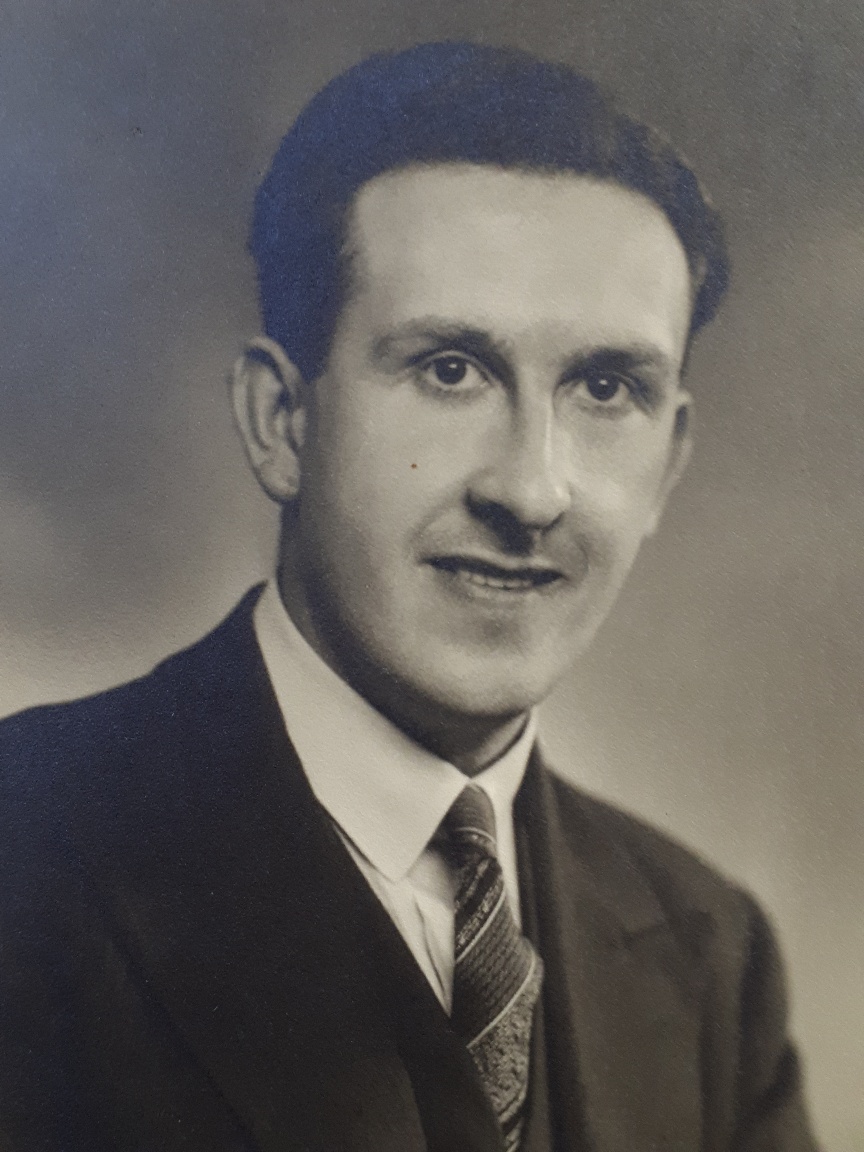
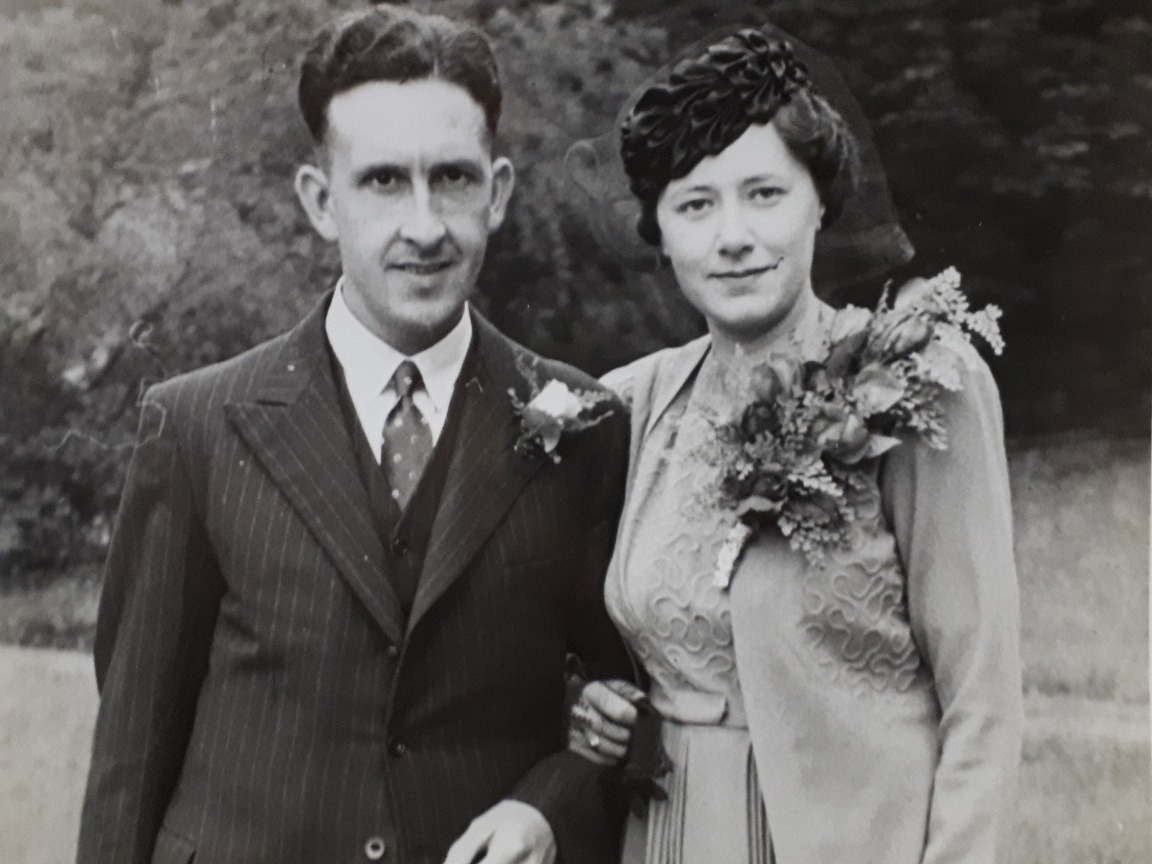
During the Second World War Mac enlisted on 16th April 1942 aged 28 into the Royal Army Medical Corps 50 General Hospital (50 BGH) (Army No. 7405034) as a dispenser/pharmacist. As an optician he would have been ‘reserved’ above the age of 30 at the start of the war but this was revised up to 35 in 1941; as a pharmacist he was in a reserved occupation at any age, so he ‘volunteered’ or perhaps used his optician qualification to circumvent this1. His rank after training at Boyce Barracks, Church Crookham, Hants was Sergeant (for regular soldiers it took ~10 years to reach this rank and nowadays he would be an officer). 50 BGH was stationed at Chepstow from March to November 1942 and in that month went to Algiers by boat from Liverpool. Chepstow at that time was ‘dry’ on a Sunday which meant walking 2 miles through town and over the River Wye to England for a drink. We know he sailed from Liverpool because he wrote to Bobbie from the boat mentioning that he had been unable before sailing to visit Uncle Reg and Bobbie’s cousin Kathleen (they lived at Southport). The censor has cut out the date from this letter, but National Archives record the locations of the numerous British General Hospitals2. By March 1944 he is rank W/S.SGT (staff sergeant for the duration of the war) and described as “must’d” (mustard presumably) in the role of ‘Adv Phar AI’. He served ‘at home’ from 16th April to 28th October 1942, in ‘North Africa’ from 29th October 1942 to 22nd June 1946 and then ‘at home’ until his release (4 years and 207 days in total). He ended overseas service at 22 (British) General Hospital stationed in Mestre adjacent to Venice where for a period he was responsible for receiving into Italy medical supplies for the country as a whole arriving in shipments of 150 tonnes. His Handing Over Certificates record that as retiring Mess Treasurer he transferred 42,266 lires held in the Cash Book and supporting Vouchers (£105 in 1945 money, or £3600 in 2019 pounds), and also stocks of Penicillin and Dangerous Drugs consistent with the balance in the Ledgers of the Medical Store. On 8th November 1946 he is released from Aldershot to the Royal Army Reserve having won the Africa Star with 1st Army Clasp and the Italy Star Defence Medal. On discharge Mac was a Dispenser Class I. His military conduct is described as ‘exemplary’ and the following Testimonial signed by (T Wiggins?) the Brigadier, Commandant of the RAMC Depot and Training Establishment, Crookham on 23rd August 1946 is given:
“A thoroughly reliable and dependable pharmacist. Has been responsible for the handling, accounting and dispensing of very large quantities of medical stores for a 1200 bed hospital, a job which he has done extremely well, showing absolute accuracy and patience. He is completely trustworthy, polite and loyal to his officers and is tactful in his dealings with subordinates.”
This is certified as being a true copy of a testimonial given by the Q.M. 22.GEN.HOSP (Quarter Master) on 19th June 1946. The National Archives show that war diaries of 22 BGH cease on 30/6/46 and the historical files close at the end of the following month. Mac’s official release on 1st August 1946 could have been more on compassionate grounds associated with the expected birth of John (that occurred on 16th August 1946) than the administration of 22 BGH as a unit.
Mac spoke little of his wartime activities but he did say he was involved with the health of prisoners of war as well as British soldiers and with the many casualties from the battles to take Monte Cassino in 1944. He was involved in the treatment of soldiers that has encountered enemy flame throwers. For several months the army lost track of him after the end of the war whilst he was in Rome. This time was used, amongst other things, with church organ lessons. There was a chance meeting of the whole family with a former army colleague (who looked a bit of a ‘spiv’) in a Kentucky Fried Chicken restaurant in London (Piccadilly Circus) around 1960. Bobbie was most put out by Mac’s deep conversation. There had apparently been some trading in Rome and in Cyril’s case the proceeds were used to purchase the Longines ‘military’ wristwatch shown in the photograph that he used until the day he died3.

Wartime Service
The only documents we have are the rather thin army records (Service Book, Release Book) and four letters written to Bobbie at the beginning and end of Mac’s overseas deployment. So, the challenge is from official records to try and piece together the route by which he went from 50 BGH at Crookham and then Chepstow in 1942 to 22 BGH at Mestre and then Crookham in 1946, via Monte Cassino and Rome, whilst neither of these hospitals supported operations at Cassino nor were located in the vicinity of Rome.
Mac had a week’s Privilege Leave from 2nd-10th July 1942 to get married, the privilege presumably recognition that training was at an end and he had assumed the rank of Sergeant. He also had 6 days Privilege Leave from 30th September 1942 in anticipation of going abroad. Whilst the war was on, the Army operated a scheme whereby any man who had served overseas for four years was repatriated. This was known as PYTHON, a reference to the Army eating its own tail. Towards the end of 1945, a new scheme was introduced named LIAP, which letters denoted Leave In Addition to Python. Under LIAP, any person who would have served overseas three years, before being demobilised, was to be given a short home leave. Mac was granted the LIAP leave that was due - 28 days - on 18th October 1945 and how he travelled home from Italy is not known, though there are reports of travelling time being longer than the period at home4. Though due PYTHON repatriation from the end of October 1946, Mac’s letters home from Mestre show that he was badgering the chain of command whilst Bobbie was contemplating having a go at both the War Office and the Commanding Officer to get him home earlier, presumably due to the impending arrival of John. Mac was still in Mestre (writing letters home) on 14th June 1946 and 16th June 1946 without knowing when leave might begin. In the event PYTHON leave of 28 days was granted probably when the testimonial was written on 19th June 1946 for the period 25th June 1946 to 22nd July 1946. Mac wrote an undated letter (probably on Friday 26th July 1946) from Boyce Barracks, Crookham noting that by the time it was received only 5 days would pass before he would be home. He took the same walk at Crookham in 1946 as he did in 1942 and records in this letter to Bobbie how little it seems to have changed in the meantime. He was released on 1st August 1946 with Release Leave to 26th September (56 days) and Overseas Leave of 43 days to 8th November 1946. Thereafter he was transferred to the Reserve.
British General Hospitals
In WWII there were 122 British General Hospitals. Of these roughly 45 were involved in the campaigns west of Suez of The Eighth Army in North Africa and thence on into Italy, becoming Central Mediterranean Forces. They were up to 1200 bed hospitals that were tented and capable of being built in 16 days and housed soldiers evacuated from the battlefield. Initial training in the UK was often on racecourses such as Chepstow or other flat ground so the hospital could be ‘moved’ several times as an exercise. Sometimes they took over permanent buildings such as schools or deserted civilian hospitals. In September 1944 penicillin became more available and this was used for both battle injuries and to treat the self-inflicted wound of VD that for example in December 1943 in Italy resulted in 80,000 man-days being lost. This was many more than in North Africa. Mac recounted the delights of ‘FFI’ inspections (freedom from infection) when the soldiers paraded and displayed themselves by dropping their trousers one after another. Lice and other skin infections were also problems in the hot climate.
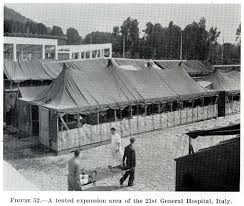
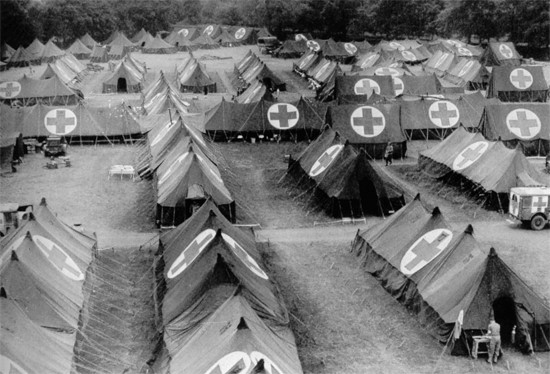
Medical Support in Italy
The Medical Services personnel had to adjust to conditions very different from those of Libya and Tunisia. The terrain was mountainous and the roads tortuous. Heavy rain and incessant traffic frequently made the routes impassable with mud. Demolition also hampered any advance. Buildings often were destroyed or booby trapped, as were roads, bridges, and culverts. Some expected the Germans to withdraw from the leg of Italy, perhaps to make a stand north of Florence, but once completely in control of northern Italy and strongly reinforced, they held on to Rome and opposed the Allied advance at the Winter Line, which ran across Italy through Cassino at the peninsula's narrowest width.
The Eighth Army's crossing of the Sangro River south of Pescara during its assault on the Winter Line provides an example of the creativity required in this campaign to evacuate the wounded in a medically sound manner. Swelled by unexpected rain, the river ran five to six feet deep in a bed 100 yards wide between sheer banks which were about ten feet high. It was crossed by an advanced dressing station, equivalent to a U.S. Army clearing company, which was wholly mobile on six Bren-gun carriers. The station established itself on the escarpment beyond.
The assembly and crossing points for the New Zealand forces were in full view of the German positions, and they were often shelled. Red Cross identifiers were not used, for fear of giving away important tactical information. When the initial attempt to evacuate casualties by amphibious vehicles proved unsuccessful, a procedure was devised whereby the patient was winched across on a stretcher slung from a 120-yard cable. This was developed into the “Flying Fox,” an aerial ropeway suspended on bipods carrying a light trolley on which a stretcher could be hitched. One was issued to each field ambulance.
Medical personnel also devised an eight-man raft by lashing together nine stretchers and covering the whole with a truck tarpaulin. The use of sleds and mule litters demonstrated further ingenuity, enabling casualties to be taken along evacuation routes that consisted of little more than rough tracks and mud. Despite these technical innovations, many casualties still had to be manhandled by stretcher-bearing (SB) squads. At least six men were required per litter, and eventually SB chains were established consisting of a series of eight-man squads, situated 300 yards apart. If the chain was long, an administrative centre would be established, as fifty bearers were needed per mile—a considerable drain on manpower.
By ingenious means and with a great expenditure of manpower, it was possible to bring casualties to the main dressing station for treatment, a medical battalion, within about four hours. It was standard practice for such a unit to have two medical companies operating in buildings—one forward to sort all the cases and to treat battle casualties, and one in the rear to act as a reception station for both sick soldiers and local casualties. As the fighting advanced, the companies would leap-frog forward. The aim was to take surgical operating as far forward as was realistically possible. It became customary to evacuate patients from the main dressing station to the field hospital with transfusions running. Field transfusion units supervised preoperative resuscitation and also distributed transfusion materials and equipment to forward units. Transfusion attachments were devised for the litters on which patients were carried—a technique far in advance of contemporary civilian practice.
In addition to the distances required for casualty evacuation, bombed-out buildings could pose challenges to medical personnel. At the Anzio beachhead, where the Eighth Army's 10 Corps fought under General Clark, the constricted tactical situation dictated that medical care be placed underground. Despite this handicap, extensive effort - including that of nurses - was put into medical support. Although medical planners had intended to provide only life-saving surgery far forward and to evacuate cases back to base hospitals, the lines of communication became so stretched that this policy could not always be maintained. Indeed, during the advance on Rome, casualty evacuation chains reached over 130 miles in length. In consequence, medical resources were brought forward in an attempt to conserve manpower.
So far as drug dispensing is concerned, in the twelve weeks following the invasion of Italy, a division's worth of men was lost from the battle front due to the hospitalization of 9,000 proven and 6,000 suspected cases of malaria. Learning from the experience gained in Sicily, malaria prophylaxis in the form of daily mepacrine tablets became compulsory, and mosquito nets and repellents were used in suspected infectious areas. A malaria field laboratory landed in Italy on D+l and carried out surveys immediately behind the advancing troops. The Eighth Army set up a malaria control organization that used power sprayers to spray DDT mixed with kerosene. Every building treated was clearly marked with the letters “DDT.” Because of its value, the production of penicillin was accelerated, despite wartime difficulties. Initially, it was issued only to the medical branches of the armed forces. The first units to receive it were the six British forward surgical units earmarked to take part in the Eighth Army's assault landings on Sicily. Soon after the invasion, the War Office, in conjunction with the Medical Research Council, sent out a penicillin research team to monitor its use in what was, essentially, a large field trial. So dramatic were penicillin's effects that later in the campaign—when supplies were running low—directives restricted its use to VD cases, since these men could, with its assistance, be quickly returned to the front. In other words, penicillin was a force multiplier. The directives were, however, not always heeded by the surgeons.
Monte Cassino and Rome
22 BGH arrived in Mestre in June 1945 from Taranto in the Puglia region of south-east Italy where it had been since January 1944. In March-May 1944 there were two contained outbreaks of smallpox amongst staff believed to have brought the disease with them from North Africa5. Mac must have been posted to Mestre in or after June 1945, perhaps in a convenient but routine change of dispensing personnel. Thus, the challenge here is to see if we can create a plausible scenario to take Mac from Cassino via semi-detachment in Rome and then to Mestre on this timescale.
The general hospitals supporting the battles for Monte Cassino were located at San Felice a Cancello 15 miles north-east of Naples and 50 miles south-east of the battlefield. The town is on the southern edge of a broad flat valley and today hosts a public hospital. There were four battles, the first beginning 17th January 1944 and the last beginning on May 11th 1944 and ending successfully 8 days later. The Geneva Convention requires each nation to look after its own wounded. This resulted in there being general hospitals at Cancello for India, New Zealand, Australia, South Africa as well as Great Britain6. Anglo-American cooperation was not great and I have not been able to establish the location of the American hospital(s). There were 55,000 casualties overall, including 20,000 Germans killed from a force of 240,000 Allied soldiers.
On 2nd September 1943, the day before the start of the Allied invasion of the Italian peninsula, a medical conference in Algiers decided that the general policy would be for casualties to be evacuated by air from Italy to North Africa and the Middle East, using Sicily only as a transit centre7. A hospital base would be developed in Naples as quickly as possible after its capture, where cases would be held that could be discharged within six weeks. Planners estimated that the Eighth Army would have 12,000 casualties within the first month and that there would be about the same number from Lt. Gen. Mark Clark's U.S. Fifth Army, which had the Eighth Army's 10 Corps under its command. As there were only 2,400 beds, difficulties were anticipated from D+12 until the Naples hospital base was well established, and it normally took sixteen days to open a 1,200-bed hospital. Eighth Army commander General Sir Bernard Montgomery well understood the value both of air evacuation and of medical cover forward that was visible to the troops. He stated, “If you do not see to this, then the troops get anxious, morale suffers, and then other troubles creep in.”
The 15th Casualty Clearing Section, a field hospital, landed on D+2 and opened in a deserted training college in Reggio; it was joined the next day by the 14th Field Ambulance, a medical battalion. Hospital ship evacuation was organized by D+6, with ships arriving daily off the beaches. Their time of arrival, however, could not be predicted, leading to large numbers of stretcher cases being held for long periods without cover. Enemy aircraft posed a serious threat. On 12th September 1943 the hospital ship Newfoundland was bombed, and five medical officers and five nurses lost their lives. On the ground, field ambulances accompanied their brigades as these went forward. By D+12, evacuation by air had begun from the airfield at Reggio.

Given this background it is not surprising that British hospital facilities at Cancello expanded rapidly in response to the casualty rate. In January 1944 100 BGH became effective, followed by 69 BGH in February and 72 BGH in May, and then in June 5 BGH, 11 BGH and 48 BGH. Finally, in July, 31 BGH began treatment. This sequencing is shown in the figure above, that identifies the deployments at Cancello, BGHs operating in Rome, their subsequent onward movement, 22 BGH’s final deployment at Mestre and Mac’s period of leave. The first point to reinforce is that neither 50 BGH in which Mac began service nor 22 BGH in which he ended it arrive at Cancello. Thus, he must have transferred to another unit to be at Cassino and then transferred to 22 BGH subsequently (22 BGH is the only hospital to be stationed at Mestre). Which of the seven Cancello hospitals is most likely? The stand-out one is 69 BGH as it left Cancello and went to Rome in March 1945 and then disbanded at the end of September 1945. The running down of 69 BGH would have provided Mac with the administrative opportunity to drift into the background in Rome before re-emerging from the shadows in order to get his LIAP approved on 18th October 1945. When he returned to Italy from leave he most likely transferred to 22 BGH and ended his service in Mestre.
This is by no means a certain hypothesis, but it is the most plausible as 48 BGH (the only other one to serve at both locations) continued on to Graz from September 1945. To the best of my recollection of his comments about the time in Rome, Mac mentioned 9 months as the period that he was anonymous. By this criterion, 69 BGH is the best fit if he became detached when it moved to Rome. For 48 BGH he would have to have become detached after the deployment in Rome had begun. Of the others, Assissi is 80 miles north of Rome, Azezzo 110 miles north of Rome, Afragola is 120 miles south east in the vicinity of Naples and Rimini on the east coast 150 miles north of Rome. For any of 5 BGH, 11 BGH, 31 BGH, 54 BGH, 72 BGH or 100 BGH to be units in which Mac served we would have to assume that he was ‘lost’ after the move from Cancello and just found has way to Rome but they had moved a distance from Rome well before the LIAP time window. In the case of 104 BGH he would have had to transfer units a second time and become detached whilst the hospital was deployed in Rome. 54 BGH also requires him to transfer units twice before Mestre. Maybe the transfer from 50 BGH to 69 BGH was temporary to alleviate the Cassino rush and this helped with the administrative confusion that facilitated the period of freedom afforded by His Majesty.
Service in North Africa
In theory Mac could have transferred from 50 BGH multiple times on his way to Cancello but it is useful to begin by considering the movements of this unit in North Africa until early 1944. This is shown in time sequence and on the map below. There is a progression from Algiers eastwards as the campaign advanced followed by a voyage to the eastern coast of Italy and then along it, following behind the front. I have assumed Mac embarked to Italy from Tripoli. It is unlikely that a transfer of units would occur before 50 BGH arrived in Italy but plausible that it might occur after the deployment in Barletta as that of 69 BGH at Cancello begins. Similarly a transfer to 5 BGH, 11 BGH or 48 BGH on the beginning of their deployment at Cancello broadly coincides with the end of the Termoli deployment of 50 BGH.

22 BGH and 69 BGH did not spend any time in North Africa. 48 BGH spent 16 months in Tripoli before Cancello. Interestingly 104 BGH spent 8 months to January 1944 in Algeria before 7 months to July at Afragola (between Cancello and Naples) and then transferred to Rome until March 1946.
We have no suggestion that Mac changed units in North Africa and the simplest explanation that accounts for what we know of his wartime trajectory is that he served in just three units, BGH 50, BGH 69 and BGH 22. Only two ‘active service’ photographs have been passed down – in both of these below Mac is on the (top) right.
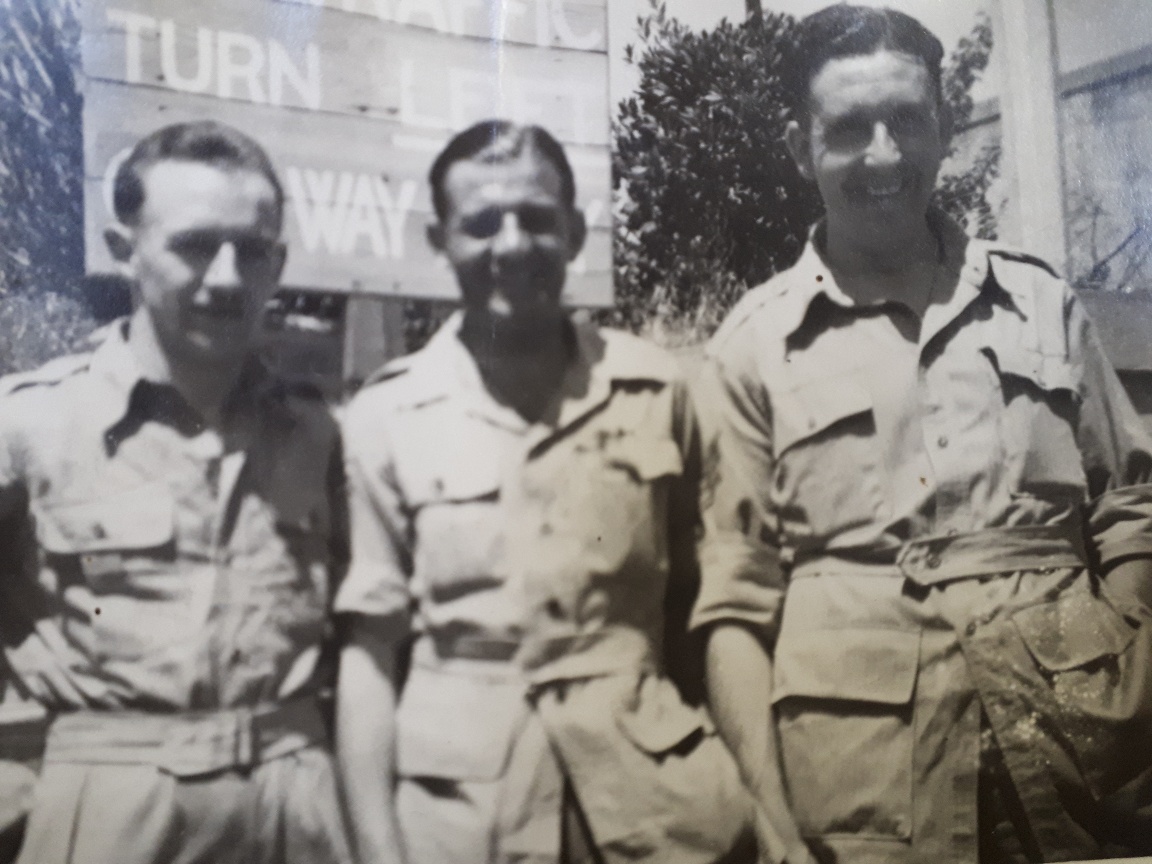
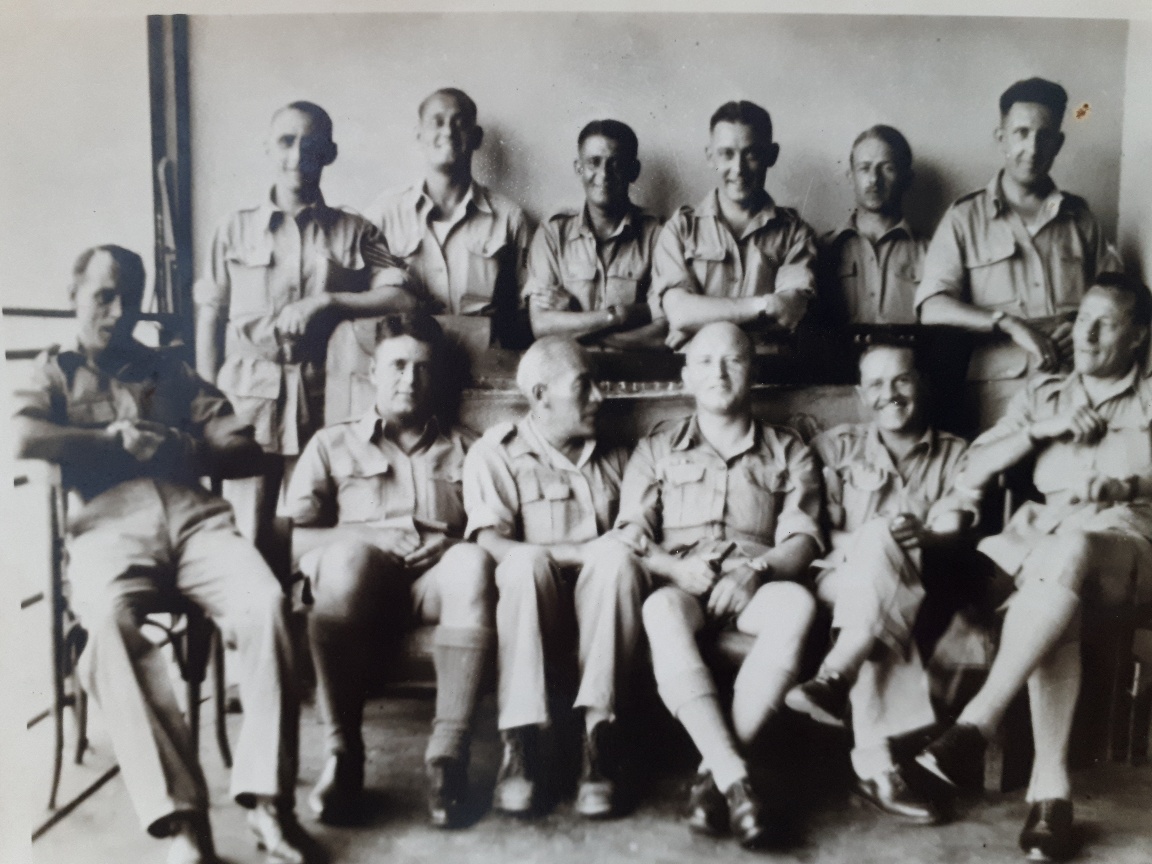
In telling grandson Peter about his wartime experiences for a school history project Mac insisted on doing this in private. Peter recalls that whilst in North Africa one Christmas fruit was bought from local traders on the strength on ‘an IOU for Winston Churchill’ and fermented into wine for the general enjoyment of one and all.
Post War Career
On joining up Mac had been a pharmacist with Leeds Industrial Cooperative Society. He returned to his previous position and worked for LICS until retirement as Chief Executive in 1978. In 1964 he had been promoted from Superintendent Chemist (responsible also for opticians) to be the Society’s first General Manager.
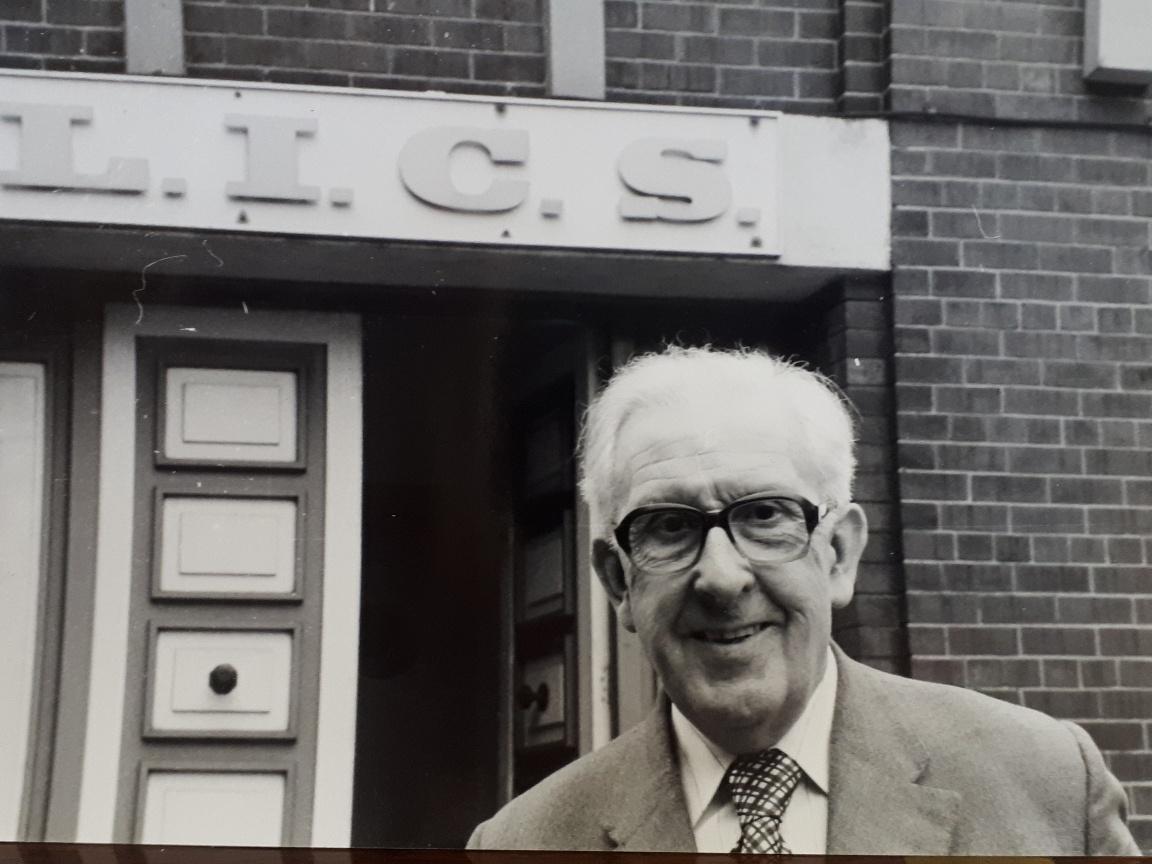
Mac died at Seacroft Hospital Leeds on July 14th 1996 aged 82.
P. McGeehin
January 2020
-
According to Juliette Pattinson, Gender & History, Vol.28 No.3 November 2016, pp. 709–727 a key change which released reserved men into the forces was the replacement in December 1941 of block reservations by occupation with that of individual deferments: a man now had to be doing a vital job in a key establishment in a reserved industry as well as meet the age requirements. Individual deferments could only be granted to men undertaking work of the utmost importance. This combing out of men from essential industries, which was made possible by the mobilisation of women, resulted in a gradual de-reservation by age groups, the disappearance of occupational reservation and the implementation of individual deferment of men according to the importance of their work. With this change from block reservation to individual deferment, the official policy of reservation came to an end and the (Reserved Occupations) Schedule ceased to exist. A system akin to that used in the First World War, with military service tribunals making decisions about recruits, then went into effect. From 1942, reserved men were required periodically to complete a form giving information about the nature of their duties to ensure that individually they were making an adequate contribution to the national war effort. There are reports of men in reserved occupations having their request to volunteer turned down and considerable social pressure on those not serving to make a more substantial contribution to the war effort. ↩︎
-
Source: http://www.scarletfinders.co.uk/112.html extracted from “The National Archives WO222/1568 ↩︎
-
According to its serial number the Longines database records that this watch was made in 1941 and supplied against order number 21111 to the company's sales representative in Egypt. New it probably cost in 1945 the equivalent of about £30 (roughly three month's pay for a Staff Sergeant). ↩︎
-
https://www.bbc.co.uk/history/ww2peopleswar/stories/42/a2040742.shtml ↩︎
-
Amy Outterside “Occupying Puglia:The Italians and the Allies, 1943-1946” Ph.D. Thesis 2015 University of Newcastle upon Tyne ↩︎
-
Kay Das “Memoirs of a Surgeon in World War II” Page Publishing New York 2018 ↩︎
-
“Medical Support for the British Eighth Arm in Italy during World War II” John D C Bennett Army History No.42 (Summer 1997) pp.22-25 accessed through https://www.jstor.org/stable/26304532 ↩︎
